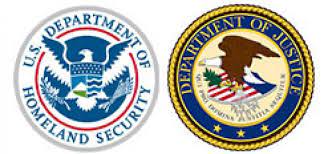DHS and DOJ Delay Implementing Trump-Era Asylum Security Regulation (Again)
The Department of Homeland Security (DHS) and Department of Justice (DOJ) announced this week that they will again postpone implementation of an asylum regulation that was finalized during the last weeks of the Trump administration. This regulation, called “Security Bars and Processing”, provided a “Title 8” alternative to “Title 42”, which is to say that it interpreted an existing immigration law that bars asylum eligibility to aliens who pose a “threat to the security of the United States” to include certain serious public health and contagious disease-related scenarios. The departments also announced that they are working to publish a new rule to solicit comments from the public regarding whether they should modify or rescind the rule.
Background. The security bars rule amended DHS and DOJ regulations to clarify that the departments may consider emergency public health concerns based on communicable disease when making a determination as to whether “there are reasonable grounds for regarding [an] alien as a danger to the security of the United States” and, thus, ineligible to be granted asylum or the protection of withholding of removal in the United States under Immigration and Nationality Act (INA) sections 208 and 241 and pertinent DHS and DOJ regulations.
Under this rule, application of this bar (as it relates to public health) would not be automatic. Officers would only apply this rule if, first, a communicable disease has triggered an ongoing declaration of a public health emergency under federal law, and an alien either exhibits symptoms indicating that he or she is afflicted with the disease or has otherwise been exposed to the disease, per guidance issued by the secretary or the attorney general, as appropriate.
Second, an alien could be ineligible for asylum and withholding of removal (on the basis of there being reasonable grounds for regarding the alien as a danger to the security of the United States) if they have been present in an already-designated region where a disease is prevalent or epidemic and the physical presence of individuals from this region would cause a danger to the public health in the United States. In order for a region to be designated for such concern, the secretary of Homeland Security and attorney general, in consultation with the secretary of Health and Human Services, must jointly determine that the physical presence of individuals during a period in which the disease is prevalent or epidemic would pose such danger to the United States. The regulation would only cover aliens who were present in an impacted region within the longest-known incubation and contagion period, so as to not arbitrarily include aliens who would no longer pose a threat due to the passage of time.
The security bars rule also requires asylum officers to apply the mandatory bars to asylum and withholding of removal at the credible fear screening stage (rather than months or years later during the final adjudication process) in order to streamline processing and minimize the spread of communicable disease. Additionally, the rule gives DHS officers authorization to remove certain aliens to third countries (meaning countries other than their country of origin) if officers determine that an alien is subject to this mandatory bar to eligibility, but nonetheless demonstrated that they are subject to a clear likelihood of persecution or torture in their home country.
That rule was scheduled to take effect on January 22, 2021, but, upon taking office, the Biden administration immediately delayed the rule’s effective date for 60 days, to March 22, 2021. The departments subsequently further delayed the rule’s effective date to December 31, 2021, and most recently to December 31, 2022. This week’s announcement extends the delay again until December 31, 2024, giving the government an additional two years to ponder the policy.
The Government’s Justification for the Delay. The government cited litigation and recent changes to its asylum regulations as the primary reason it was seeking to delay the effective date for an additional two years. Notably, the security bars final rule relies on the regulatory framework that was established under what is known as the “Global Asylum rule”, a regulation published by the Trump administration that was enjoined by a federal district court on January 8, 2021. DHS and DOJ explained that the text of the security bars rule reflects an assumption that the global asylum final rule would be in effect and, therefore, the security bars rule did not make necessary changes to the existing credible fear regulations.
The government also cited recent regulatory changes made by the Biden administration under what is known as the “Asylum Processing Interim Final Rule (IFR)” as its basis for delaying the effective date. This IFR changed the credible fear process by allowing asylum officers, rather than immigration judges, to make final decisions to grant asylum to aliens who make a fear claim at the border. In their Federal Register announcement, the departments wrote, “The intervening Asylum Processing IFR has made significant changes to the regulations governing the credible fear screening framework and standards, and because these changes are incompatible with applying the Security Bars rule according to its terms, these intervening regulatory changes further justify delaying the effective date of the Security Bars rule.”
The problem with this rationale is that the government has had plenty of opportunity to address these obstacles. In fact, in January 2021, when the government sought to delay the effective date of the security bars rule the first time, it solicited comments from the public and could have amended the regulatory text any time after considering the comments it received. It had a second opportunity to make the necessary regulatory changes when it issued the asylum processing IFR. The fundamental policies created by the asylum processing IFR and security bars rule can easily be reconciled.
Further, the injunction of the global asylum rule is premised on DHS chain of succession issues (regarding the transfer of power from former Secretary of Homeland Security Nielsen to Former-Acting Secretary McAleenan to Former-Acting Secretary Wolf). As I wrote months ago, now that Secretary Alejandro Mayorkas is confirmed in office, DHS no longer is subject to this issue. Therefore, DHS could reissue an amended version (or parts of it) if it chose to. While the data and procedural history would need to be updated, much of the work that goes into drafting a regulation was already completed by the end of 2020.
Public Health Is a Security Issue. DHS and DOJ should consider serious economic concerns and other non-terrorism related grounds when applying this bar to asylum and withholding eligibility. As the entire world learned the hard way in 2020, public health crises can quickly implicate national security capabilities, and the danger posed by international travel during a pandemic is unique. As the departments cited in the security bars final rule, former Secretary of Homeland Security Michael Chertoff stated in 2006, “[a] severe pandemic … may affect the lives of millions of Americans, cause significant numbers of illnesses and fatalities, and substantially disrupt our economic and social stability.”
In addition to the immense human toll, a pandemic or other contagious public-health crisis has the potential to both devastate the economy, stress medical service providers, and impede U.S. government operations, particularly with regard to border security and other related functions. Further, the global spread of pandemics can impact military readiness, thus posing a direct threat to national security.
In 2020, DHS emphasized that the option to use this authority was needed because, in many cases, it may not be possible to know whether any particular individual is infected at the time of apprehension or application. Additionally, as we experienced during the Covid-19 pandemic, sufficient testing, treatments, and resources needed to contain the spread of a disease may not be available for months into a crisis.
Why Does This Matter Now? As my colleague Andrew Arthur has reported, the Biden administration has been attempting to terminate a public-health order issued by the Centers for Disease Control and Prevention (CDC) under its Title 42 authorities since 2021, and the order has been subject to recent court orders ruling against its validity. Just this week, the U.S. Supreme Court ruled the CDC’s order can remain in effect until the Court can consider whether states have the legal ability to challenge the government’s plans. Even so, news regarding the near-end to use of Title 42 authorities at the border has resulted in a record-breaking numbers of illegal border crossings – even despite recent rates already reported at record-breaking highs since January 2021 by the U.S. Customs and Border Protection.
If the Biden administration has another tool to address the border crisis and can choose to only “turn it on” when it determines that it is necessary to protect the security of the United States, why hasn’t it allowed the regulatory language to go into effect? If the government has the resources to redesign the credible fear process, as it did with the asylum process IFR, it certainly could also make the tweaks needed to implement this authority.



.png)

